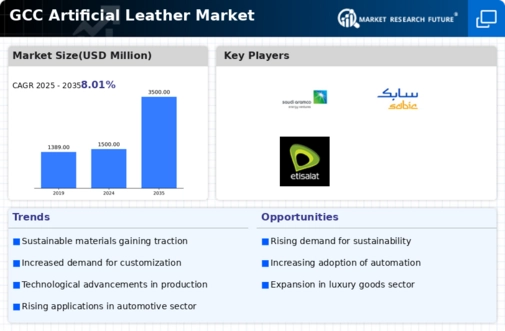Growing Automotive Sector
The automotive sector in the GCC is experiencing robust growth, which is positively impacting the artificial leather market. As car manufacturers increasingly seek lightweight and cost-effective materials for vehicle interiors, artificial leather is becoming a preferred choice. The artificial leather market is poised to capitalize on this trend, with the automotive segment projected to account for approximately 25% of total market share by 2025. This shift is driven by the need for durable, easy-to-clean, and aesthetically pleasing materials that meet consumer expectations. The growth of the automotive sector is thus a significant driver for the artificial leather market, indicating a promising future for manufacturers.
Expansion of the Fashion Industry
The artificial leather market is significantly influenced by the expansion of the fashion industry in the GCC. With a burgeoning middle class and increasing disposable incomes, there is a rising appetite for fashionable and affordable alternatives to genuine leather. The artificial leather market is benefiting from collaborations between designers and manufacturers, leading to innovative product lines that appeal to a diverse consumer base. In 2025, the fashion sector in the GCC is expected to grow by 10%, further propelling the demand for artificial leather products. This growth indicates a shift in consumer preferences towards stylish yet cost-effective materials, positioning artificial leather as a viable option in the competitive fashion landscape.
Government Regulations and Support
Government regulations and support are increasingly influencing the artificial leather market in the GCC. Authorities are implementing policies aimed at promoting sustainable practices and reducing reliance on animal products. This regulatory environment encourages manufacturers to invest in artificial leather production, aligning with national goals for sustainability and economic diversification. The artificial leather market is likely to benefit from incentives and funding opportunities provided by governments, fostering innovation and growth. As a result, the market is expected to expand, with an estimated growth rate of 7% annually, driven by supportive government initiatives.
Rising Demand for Eco-Friendly Products
The artificial leather market is experiencing a notable increase in demand for eco-friendly products, particularly within the GCC region. Consumers are becoming more environmentally conscious, leading to a shift towards sustainable alternatives to traditional leather. This trend is reflected in the growing preference for artificial leather made from recycled materials or bio-based sources. As a result, manufacturers are investing in innovative production techniques that minimize environmental impact. The GCC market is projected to witness a growth rate of approximately 8% annually, driven by this rising demand for sustainable options. The artificial leather market is thus adapting to meet consumer expectations while also addressing environmental concerns.
Technological Innovations in Production
Technological advancements are playing a crucial role in shaping the artificial leather market. Innovations in manufacturing processes, such as 3D printing and advanced coating techniques, are enhancing the quality and durability of artificial leather products. These technologies allow for greater customization and efficiency, which is particularly appealing to manufacturers in the GCC. The artificial leather market is likely to see a surge in production capabilities, with a projected increase in output by 15% over the next few years. This technological evolution not only improves product offerings but also reduces costs, making artificial leather a more attractive option for various applications.

















Leave a Comment